Yealink SIP VP59 Manual
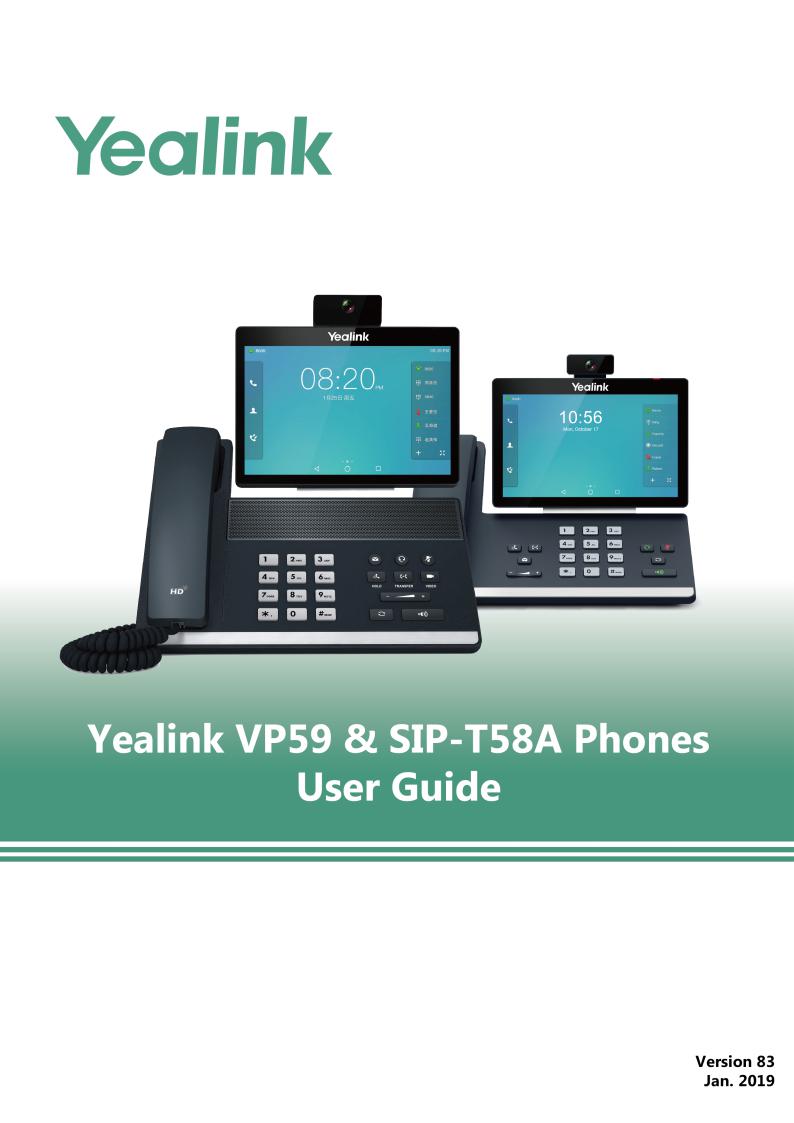
Copyright
Copyright © 2019 YEALINK(XIAMEN) NETWORK TECHNOLOGY
Copyright © 2019Yealink (Xiamen) Network Technology CO., LTD. All rights reserved. No parts of this publication may be reproduced or transmitted in any formor by any means, electronic or mechanical, photocopying, recording, or otherwise, for any purpose, without the express written permission of Yealink (Xiamen) Network Technology CO., LTD.
Under the law, reproducing includes translating into another language or format.
When this publication is made available on media, Yealink (Xiamen) Network Technology CO., LTD. gives its consent to downloading and printing copies of the content provided in this file only for private use but not for redistribution. No parts of this publication may be subject to alteration, modification or commercial use. Yealink (Xiamen) Network Technology CO., LTD. will not be liable for any damages arising fromuse of an illegally modified or altered publication.
Trademarks
Yealink®, the logo and the name and marks is trademark of Yealink (Xiamen) Network Technology CO., LTD, which are registered legally in China, the United States, EU (European Union) and other countries.
All other trademarks belong to their respective owners. Without Yealink’s express written permission, recipient shall not reproduce or transmit any portion hereof in any formor by any means, with any purpose other than personal use.
Warranty
(1) Warranty
THE SPECIFICATIONSANDINFORMATION REGARDING THE PRODUCTSIN THISGUIDE ARE SUBJECT TO CHANGE WITHOUT NOTICE. ALL STATEMENTS, INFORMATION, ANDRECOMMENDATIONSIN THISGUIDE ARE BELIEVEDTO BE ACCURATE ANDPRESENTEDWITHOUT WARRANTY OF ANY KIND, EXPRESSOR IMPLIED. USERSMUST TAKE FULL RESPONSIBILITY FOR THEIR APPLICATION OF PRODUCTS.
(2) Disclaimer
YEALINK (XIAMEN) NETWORK TECHNOLOGY CO., LTD. MAKESNO WARRANTY OF ANY KINDWITH REGARDTO THIS GUIDE, INCLUDING, BUT NOT LIMITEDTO, THE IMPLIEDWARRANTIESOF MERCHANTABILITY ANDFITNESSFOR A PARTICULAR PURPOSE. Yealink (Xiamen) Network Technology CO., LTD. shall not be liable for errors contained herein nor for incidental or consequential damages in connection with the furnishing, performance, or use of this guide.
(3) Limitation of Liability
Yealink and/or its respective suppliers are not responsible for the suitability of the information contained in this document for any reason. The information is provided “as is”, and Yealink does not provide any warranty and is subject to change without notice. All risks other than risks caused by use of the information are borne by the recipient. In no event, even if Yealink has been suggested the occurrence of damages that are direct, consequential, incidental, special, punitive or whatsoever (Including but not limited to loss of business profit, business interruption or loss of business information), shall not be liable for these damages.
End User License Agreement
This End User License Agreement ("EULA") is a legal agreement between you and Yealink. By installing, copying or otherwise using the Products, you: (1) agree to be bounded by the terms of this EULA, (2) you are the owner or an authorized user of the device, and (3) you represent and warrant that you have the right, authority and capacity to enter into this agreement and to abide by all its terms and conditions, just as if you had signed it. The EULA for this product is available on the Yealink Support page for the product.
Patent Information
China, the United States, EU (European Union) and other countries are protecting one or more patents of accompanying products and/or patents being applied by Yealink.
Customer Feedback
We are striving to improve our documentation quality and we appreciate your feedback. Email your opinions and comments to DocsFeedback@yealink.com.
Technical Support
Visit Yealink WIKI (http://support.yealink.com/) for the latest firmware, guides, FAQ, Product documents, and more. For better service, we sincerely recommend you to use Yealink Ticketing system(https://ticket.yealink.com) to submit all your technical issues.
GNU GPL INFORMATION
Yealink phone firmware contains third-party software under the GNU General Public License (GPL). Yealink uses software under the specific terms of the GPL. Please refer to the GPL for the exact terms and conditions of the license.
The original GPL license, source code of components licensed under GPL and used in Yealink products can be downloaded online: http://www.yealink.com/onepage_83.html.

Table of Contents
Table of Contents
Before You Begin
Related Documentation
Getting Started with Your Phone
Hardware Overview
VP59Hardware
T58A Hardware
Power LEDIndicator
Camera LEDIndicator
Screen and Icons
Control Center and Notification Center
Idle Screen
The Home Screen
The Second Idle Screen
The Third Idle Screen
Video Call Screen
Icons in the Status Bar
Line Key Icons
Navigating Menus and Fields
Entering Information
Using the Onscreen Keyboard
English (UK) Input Method
Google Pinyin Input Method
Using the Phone Keypad and Dial Pad
Call Features
Changing the Default Account
Placing Calls
Placing a Call fromthe Dialer
Placing Multiple Calls
Placing a Call with a Speed Dial Key
Placing a Call Back to the Last Incoming Number
Redialing a Number
Dialing a Hotline Number
Placing an International Call
Placing a Call fromthe Call History
Placing a Call fromthe Directory
Placing an Anonymous Call
Placing a Call fromthe Google Contacts
Answering Calls
Answering a Call
Table of Contents
1
12
12
13
13
13
15
17
17
18
18
19
19
20
21
22
23
24
24
25
25
26
28
29
31
31
31
32
32
32
33
33
33
34
34
34
34
35
36
36
1

Yealink VP59& SIP-T58A Phones User Guide
Answering a Call When in a Call
Answering a Call Automatically
Disabling Call Waiting
Switching Among the Handset, Speakerphone and Headset Modes Audio-only/Video Call Selection
Placing an Audio-only/Video Call
Answering a Video Call
Switching between Video Call and Audio-only Call
Switching to the Audio-only Call
Initiating a Video Call
Accepting or Ignoring a Video Call Request
Switching Between Calls Screen and Idle Screen
Going Back to the Idle Screen during a Call
Returning to the Talking Screen
Options during a Video Call
Stopping Transmitting Video during a Call
Changing the Video Layout during a Call
Swapping Video
Changing the Video Layout to the Same Size Mode Changing the Video Layout to the Full Screen Mode Hiding the Local Video Window
Previewing the Near-Site Video
Capturing a Screenshot
Capturing a Screenshot When the Phone is Idle
Capturing a Screenshot during a Call
Viewing the Latest Screenshot
Silencing or Rejecting Incoming Calls
Silencing a Call
Rejecting a Call Manually
Rejecting Anonymous Calls
Rejecting Calls with Do Not Disturb (DND)
Rejecting Calls with DNDon All Lines
Rejecting Calls with DNDon a Specific Line
Deactivating DND
Ending Calls
Redialing a Call Automatically
Muting/Unmuting Audio
Keep Mute
Holding and Resuming Calls
Holding a Call
Resuming a Held Call
Redirecting Incoming Calls
Forwarding All Incoming Calls to a Contact
Forwarding All Incoming Calls on All Lines
36
37
37
38
38
38
39
39
40
40
40
40
40
40
41
41
41
41
42
43
43
43
44
44
44
44
45
45
45
45
46
46
47
47
48
48
49
49
50
50
51
51
51
51
2

Forwarding All Incoming Calls on a Specific Line
Deactivating Call Forward
Forwarding an Incoming Call Manually
Forwarding Incoming Calls with a Forward Key
Transferring Calls
Performing a Blind Transfer
Performing a Blind Transfer Normally
Performing a Blind Transfer Conveniently
Performing a Semi-Attended/Attended Transfer
Performing Transfer with a Transfer Key
Setting a Transfer Key
Performing a Blind Transfer Using a Transfer Key Performing a Semi-attended/Attended Using a Transfer Key
Conference Calls
Local Conference
Setting Up a Local Conference Call
Merging Two Calls into a Conference
Creating a Hybrid Conference
Holding or Resuming a Conference Call
Muting or Unmuting a Conference Call
Splitting a Conference Call
Managing Conference Participants
Ending a Conference Call
Network Conference
Setting Up a Network Conference
Call Recording
Recording a Call
Recording a Conference
Setting a Mark When Recording a Call
Stopping a Recording
Checking Storage Space
Multicast Paging
Sending Multicast Paging
Setting a Multicast Paging Key
Sending a Paging by a Multicast Paging Key
Setting a Paging List Key
Setting a Paging Group
Sending Pages by a Paging List Key
Deleting a Paging Group
Receiving Multicast Paging
Managing a Paging Call
Advanced Call Features
Using Call Completion
Call Pickup
Table of Contents
52
52
53
53
53
54
54
54
55
56
56
56
57
57
57
58
58
59
60
60
60
60
60
60
61
61
61
62
62
62
63
63
63
64
64
65
65
65
66
66
66
67
67
68
3

Yealink VP59& SIP-T58A Phones User Guide
Picking up a Call Directly
Picking up a Group Call Directly
Picking up a Call with a Directed Pickup Key Picking up a Call with a Group Pickup Key
Call Park and Call Retrieve
Parking or Retrieving a Call in the FACMode Parking a Call in the FACMode Retrieving a Parked Call in the FACMode
Parking or Retrieving a Call in the Transfer Mode Parking a Call in the Transfer Mode Retrieving a Parked Call in the Transfer Mode
Parking or Retrieving a Call with a Park or Retrieve Key State Indicator of the Park/Retrieve key
Parking a Call using a Park Key
Retrieving a Parked Call using a Retrieve Key Busy Lamp Field (BLF)
Setting a BLF Key
State Indicator of Remote Line by BLF Key
Visual Alert for Monitored Lines
Picking up a Remote Call by BLF Key
Transferring a Call by BLF Key
Performing a Blind Transfer
Performing a Semi-attended/Attended Transfer Parking or Retrieving a Call by BLF Key
Parking a Call to a Monitored Line
Retrieving a Parked Call
BLF List
State Indicator of Remote Line by BLF List Key Visual Alert for Monitored Lines
Picking up a Remote Call by BLF List Key
Transferring a Call by BLF List Key
Performing a Blind Transfer
Performing a Semi-attended/Attended Transfer Retrieving a Call by a BLF List Key
Barging in an Active Call by BLF List Key
Shared Line
State Indicator of Shared Line
Placing Calls on a Shared Line
Answering Calls on a Shared Line
Placing a Call on Public Hold
Placing a Call on Private Hold
Retrieving a Held Call on a Shared line
Barging in an Active Call on a Shared line
Pulling a Shared Call on a Shared line
68
69
69
70
70
70
70
71
71
72
72
72
72
73
73
74
74
74
75
75
75
76
76
76
76
76
77
77
77
78
78
78
78
78
79
79
79
80
80
80
80
81
81
82
4

Intercom
State Indicator of the Intercomkey
Placing an IntercomCall
Picking up an Incoming Call of the Target Extension Answering an IntercomCall
Video/Voice Mail
Setting the Voice Mail Code
Leaving Voice Mails
Listening to Voice Mails
Using the Hot Desking
Automatic Call Distribution (ACD)
State Indicator of ACDUser
Logging into the ACDSystem
Changing the ACDStatus
Directory
Local Directory
Managing the Local Directory Groups
Adding Contact Groups
Editing Contact Groups
Deleting Contact Groups
Managing the Local Directory Contacts
Adding Contacts
Viewing Contacts
Editing Contacts
Deleting a Contact
Deleting All Contacts
Moving a Local Directory Contact to Blacklist
Moving a Local Directory Contact to the Shared Directory Searching for Contacts
Blacklist
Adding a Blacklist Contact
Viewing Blacklist Contacts
Editing a Blacklist Contact
Deleting Blacklist Contacts
Deleting a Blacklist Contact
Deleting All Blacklist Contacts
Moving a Blacklist Contact to the Local Directory Mobile Contacts
Saving a Mobile Contact to the Local Directory
Searching for Mobile Contacts
Updating the Mobile Contacts
Google Contacts
Enabling the Google Contacts Feature
Viewing Google Contacts
Table of Contents
82
82
83
83
84
85
85
85
85
86
86
86
87
87
89
89
89
89
89
90
90
90
90
90
91
91
91
91
92
92
93
93
93
93
93
93
94
94
94
95
95
96
96
96
5

Yealink VP59& SIP-T58A Phones User Guide
Adding a Google Contact
Editing a Google Contact
Deleting a Google Contact
Searching for Google Contacts
Manually Updating the Google Contacts
Remote Phone Book
Searching for Remote Phone Book Contacts
Viewing Remote Phone Book Contacts
Saving a Remote Phone Book Contact to the Local Directory Saving a Remote Phone Book Contact to the Blacklist
Call History
Call History Icons
Viewing History Records
Saving a History Record to Local Directory
Saving a History Record to Blacklist
Adding a History Record to Shared Directory
Deleting History Records
Deleting a Call Record
Deleting All Call Records
Disabling History Record
System Applications
Managing Applications and Widgets
Adding a Widget to the Idle Screen
Resizing a Widget
Moving an Application or Widget
Removing a Widget fromthe Idle Screen
Creating a Folder
Renaming a Folder
Managing Running Applications
APP Accounts
Adding APP Accounts
Syncing APP Account Information
Removing APP Accounts
File Manager
Viewing Files
Searching Files
Copying Files
Cutting Files (Moving Files)
Deleting Files
Sharing Pictures/Videos/Audio via Bluetooth
Sharing Pictures/Videos/Audio via Email
Gallery
Viewing Pictures/Videos
96
97
97
97
98
98
98
98
98
99
101
101
101
101
101
102
102
102
102
103
105
105
105
105
106
107
107
108
108
109
109
110
111
111
111
111
112
112
113
113
114
115
116
6

Editing Pictures
Rotating Pictures
Adding a Filter for Pictures
Adding a Frame for Pictures
Cropping Pictures
Coloring Pictures
Setting a Picture as Wallpaper
Printing Pictures
Deleting Pictures/Videos
Taking a Picture/Video
Sharing Pictures/Videos via Bluetooth
Sharing Pictures/Videos via Email
Recorder
Recording Audio
Playing a Recorded Call
Pause/Resuming a Playback
Fast Forwarding/Rewinding a Playback
Stopping a Playback
Renaming the Recording
Deleting a Recording
Deleting All Recordings
Checking Storage Space
Camera
Inserting the USB Camera to the Phone
Taking Pictures
Recording Videos
Camera Settings
Signing In Email
Sending Emails
Reading Emails
Deleting Emails
Marking/Printing Email
Adding Multiple Email Accounts
Using Email Widget
Sending Files via Email
Browser
Browsing a Web Page
Managing Bookmarks
Adding a Web Page to the Bookmarks Library Accessing a Web Page fromthe Bookmarks Library Editing a Bookmark
Deleting a Bookmark
Setting a Home Page
Table of Contents
116
117
117
117
117
118
118
118
119
119
120
121
122
123
123
124
124
124
124
125
125
125
125
125
126
126
127
127
127
127
128
128
128
129
129
130
130
130
131
131
131
132
132
132
7

Yealink VP59& SIP-T58A Phones User Guide
Clearing the Navigation History
Modifying the Browser Settings
Calendar
Signing Into Calendar
Creating an Event
Checking Events
Modifying the Calendar Settings
Calculator
Clock
Alarm
Setting an AlarmClock
Editing an AlarmClock
Deleting an AlarmClock
Setting the AlarmParameters
Clock
Adding the Clock of Other Cities
Configuring the Clock Display Mode
Setting a Timer
Setting a Stopwatch
Customizing Your Phone
Changing the Administrator Password
Wallpaper
Changing Wallpaper on Idle Screen Adding a Wallpaper froma USB Flash Drive
Screen Saver
Changing the Waiting Time for Screen Saver Setting the Screen Saver Type
Changing the Screen Backlight and Time
Changing the Language
Changing the Input Method
Time & Date
Setting the Time and Date Manually
Changing the Time and Date Format
Setting a Key as Send
Phone Lock
Setting the Phone Lock
Locking Your Phone Manually
Unlocking Your Phone
Changing Your Phone Unlock PIN
Line Keys
Assigning Functionality to a Line Key Changing the Locations of the Line Keys Deleting a Line Key
133
133
133
133
134
134
135
136
136
136
136
137
137
137
138
138
138
139
139
141
141
141
141
142
142
142
142
143
144
144
145
145
146
146
146
146
147
147
147
148
148
149
149
8

Audio Settings
Adjusting the Volume
Setting the Ring Tone
Setting a Ring Tone for the Phone
Setting a Ring Tone for an Account
Setting a Ring Tone for a Group
Setting a Ring Tone for a Contact
Disabling the Key Tone
Enabling Touch Tone
Configuring Notification Sound
Enabling Silent Mode
Bluetooth
Activating the Bluetooth Mode
Pairing and Connecting the Bluetooth Headset
Pairing and Connecting the Bluetooth-enabled Mobile Phone Syncing the Mobile Contacts to the Phone
Enabling the Mobile Contacts Sync Feature
Viewing Your Mobile Contacts
Handling a Mobile Phone Call on the Phone
Configuring the Phone Audio Feature
Configuring the Media Audio Feature
Changing Your Phone's Bluetooth Name
Disabling Bluetooth Device Discovery
Renaming the Paired Bluetooth Device
Unpairing the Bluetooth Device
Sending Files via Bluetooth
Receiving Files via Bluetooth
Disconnecting the Bluetooth Device
Deactivating the Bluetooth Mode
Wireless Network
Activating the Wi-Fi Mode
Connecting to the Wireless Network
Connecting to an Available Wireless Network Manually Connecting to the Wireless Network Using Wi-Fi Protected Setup Adding a Wireless Network Manually
Viewing the Wireless Network Information
Disconnect froma Wireless Network
Deactivating the Wi-Fi Mode
Optional Accessories with Your Phone
Headset
Connecting the Analog Headset
Bluetooth Headset
USB Headset
Table of Contents
151
151
151
151
151
152
152
152
153
153
153
154
154
154
155
156
156
157
157
158
158
158
159
159
159
159
160
160
160
162
162
162
162
163
164
164
164
165
167
167
167
167
167
9

Yealink VP59& SIP-T58A Phones User Guide
Using Headsets
Expansion Module and Your Phone
Connecting the Expansion Module
Assigning the Features for Ext Keys
Adjusting the Screen Saver of Expansion Module
Adjusting the Backlight of Expansion Module
Changing the EXP Wallpaper fromPhone
Adding an EXP Wallpaper froma USB Flash Drive
Using Handsets on the VP59/T58A Phone
Attaching the DECT USB Dongle DD10K Handset Registration
Setting the Phone to the Handset Registration Mode Registering a Handset to the Phone
De-registering a Handset on the Handset
De-registering a Handset on the Phone
DECT Intercom
Configuring Auto Intercom
Placing a DECT IntercomCall on the Handset
Placing a DECT IntercomCall on the Phone
Placing a DECT IntercomCall with a DECT IntercomKey Performing a Blind Transfer to the Handset
Merging the DECT IntercomCall with SIP Call into a Conference Repeater Mode
Enabling the Repeater Mode
Setting the Phone to the Repeater Registration Mode Registering a Repeater
Master-Slave Mode
Selecting a Slave Handset for Your Phone
Push an Active Call to the Slave Handset
Pull an Active Call fromthe Slave Handset
Shared Directory
Adding Shared Contacts
Viewing Shared Contacts
Editing Shared Contacts
Deleting a Shared Contact
Deleting All Shared Contacts
Searching for Shared Directory Contacts
Moving a Shared Contact to the Blacklist Directory
Saving a Shared Contact to the Local Directory
Placing a Call fromthe Shared Directory
Renaming the Handset
Locating a Handset
Changing Base PIN
168
168
168
168
169
169
169
169
171
171
171
171
172
172
172
173
173
173
174
174
174
175
175
175
175
176
176
176
177
177
178
178
178
178
179
179
179
179
180
180
180
180
180
10

Table of Contents
Maintaining Your Phone |
183 |
|
Investigating Warnings |
183 |
|
Clearing Warning Icon |
||
183 |
||
Rebooting Your Phone |
||
184 |
||
Resetting to Factory Settings |
||
184 |
||
Updating the Phone Configuration |
||
184 |
||
|
||
Appendix - Menu Structure |
187 |
11

Yealink VP59& SIP-T58A Phones User Guide
Before You Begin
This guide provides information you need to quickly use your new phone.
Firstly, verify with your systemadministrator that the IP network is ready for phone configuration. Also be sure to read the Quick Start Guide which can be found in your phone package before you set up and use the phone. As you read this guide, keep in mind that some features are only configurable by your systemadministrator or determined by your phone environment. As a result, some features may not be enabled or may be operated differently on your phone. Additionally, the examples and graphics in this guide may not directly reflect what is displayed or is available on your phone screen.
Note
This guide mainlytakes the SIP-T58A phones as an example.
Related Documentation
You can view more types of documents to make the phone to performmore functions.
You can obtain additional information of the following phones fromYealink Support:
•Flagship Smart Video Phone VP59
•Smart Business Phone SIP-T58A
The following types of related documents are available on each support page on Yealink support page:
•Release Notes, which details bug fixes and feature enhancements when an update is released.
•Quick Start Guide, which describes how to assemble your phone and configure the basic phone features.
•Wall Mount Installation Guide, which provides detailed instructions on how to use an optional wall mount bracket to mount your phone on the wall. It is only applicable to SIP-T58A phones.
•Administrator Guide, which provides the detailed information on how to configure phone features for systemadministrator.
•Regulatory Notice, which provides information about all regulatory and safety guidance.
You can also view other user documents which provide descriptions and examples for phone settings and features on Yealink support page.
12
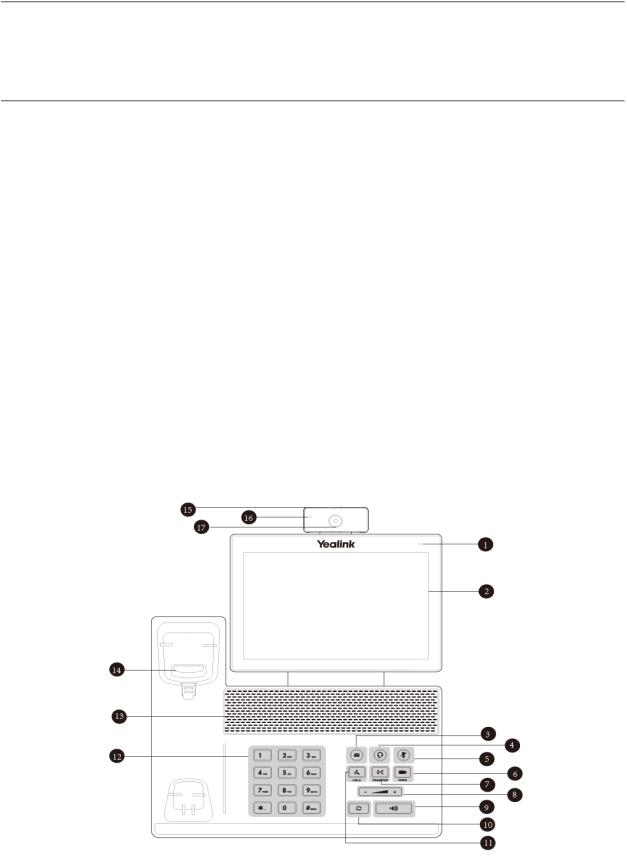
Getting Started with Your Phone
Getting Started with Your Phone
Before you use your phone, take some time to get familiar with its features and user interface.
The terms "the phone" and "your phone" refer to any of the IP phones. Unless specifically noted in this guide, all phone models are operated in similar ways.
Topics
Hardware Overview
Screen and Icons
Navigating Menus and Fields
Entering Information
Hardware Overview
Understanding the phone hardware helps you easily use the phone's features.
Topics
VP59Hardware
T58A Hardware
Power LEDIndicator
Camera LEDIndicator
VP59 Hardware
13
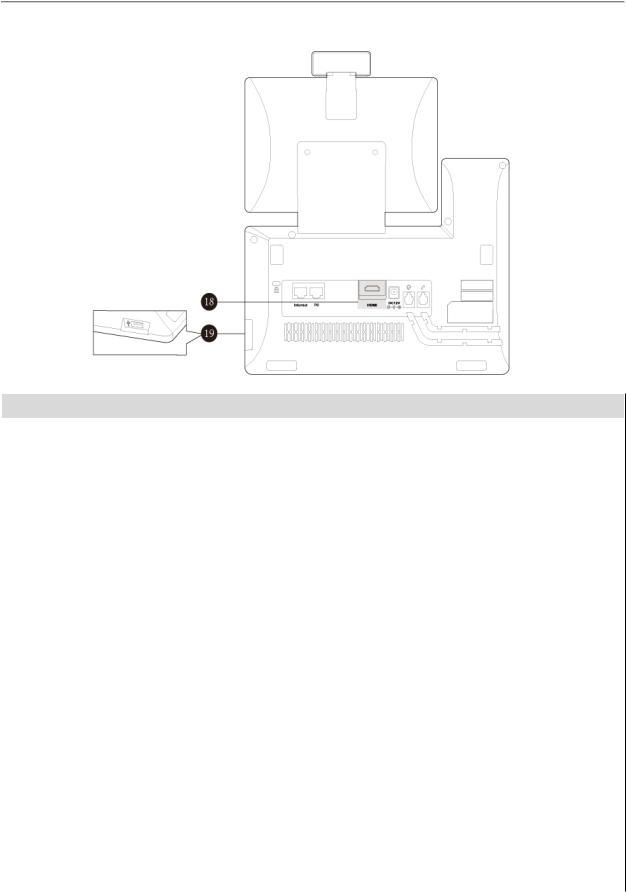
Yealink VP59& SIP-T58A Phones User Guide
No. |
Item |
Description |
|
|
|
|
|
1 |
Power LED |
Indicates call status, message status and phone’s systemstatus. |
|
|
indicator |
|
|
|
|
Allows you to select items and navigate menus on the touch-sensitive screen. Tap to select |
|
2 |
Touch Screen |
and highlight screen items. |
|
|
|
Shows information about calls, messages, time, date and other relevant data. |
|
3 |
MESSAGE Key |
• Accesses voice mails. |
|
|
|
• Captures screenshots during a video call. |
|
4 |
HEADSET Key |
Toggles and indicates the headset mode. |
|
|
|
The key LEDglows green when headset mode is activated. |
|
5 |
MUTE Key |
Toggles and indicates mute feature. The key LEDglows red when the call is muted. |
|
|
|
|
|
6 |
VIDEO Key |
• Allows you to preview local-site video when the phone is idle. |
|
• Controls the transmission of video images during calls and conferences. |
|
||
|
|
|
|
|
|
|
|
7 |
TRANSFER Key |
Transfers a call to another party. |
|
|
|
|
|
8 |
Volume Key |
Adjusts the volume of the handset, headset and speaker. |
|
|
|
|
|
9 |
Speakerphone |
Toggles and indicates the hands-free (speakerphone) mode. The key LEDglows green when |
|
|
Key |
the hands-free (speakerphone) mode is activated. |
|
10 |
REDIAL Key |
Redials a previously dialed number. |
|
|
|
|
|
11 |
HOLDKey |
Places a call on hold or resumes a held call. |
|
|
|
|
|
12 |
Keypad |
Provides the digits and special characters in context-sensitive applications. |
|
|
|
|
|
13 |
Speaker |
Provides hands-free (speakerphone) audio output. |
|
|
|
|
|
|
|
• Picking up the handset fromthe handset cradle, the hookswitch bounces and the phone con- |
|
14 |
Hookswitch |
nects to the line. |
|
|
|
• Laying the handset on the handset cradle, the phone disconnects fromthe line. |
|
|
|
|
|
14
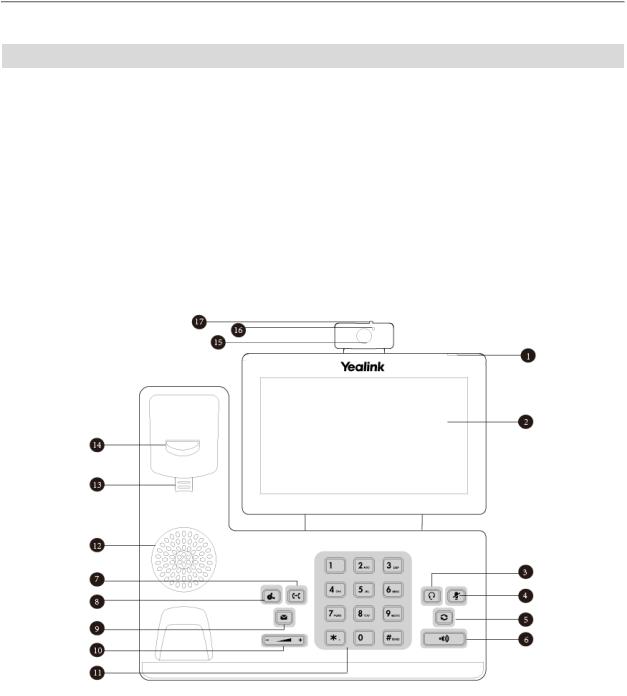
Getting Started with Your Phone
No. |
Item |
Description |
|
|
|
15 |
Privacy Shutter |
Covers and uncovers the camera. When the camera is switched off, the video image turns to |
|
|
be black. |
16 |
Camera LED |
Indicates video call status and camera status. |
|
indicator |
|
17 |
Camera Lens |
2Mega-pixel camera. Provides near-site video. The best distance between camera and the |
|
|
images you want to capture should be within 0.35meters (1foot) to 2meters (6feet). |
|
|
Allows you to connect an external monitor (optional) to your phone and the video image cap- |
18 |
HDMI Port |
tured fromcamera (both near site and far site) will also be shown on the external monitor dur- |
|
|
ing a video call. |
19 |
USB2.0Port |
Allows you to connect an optional USB device (for example, USB flash drive, DD10K) to your |
|
|
phone. |
T58A Hardware
15
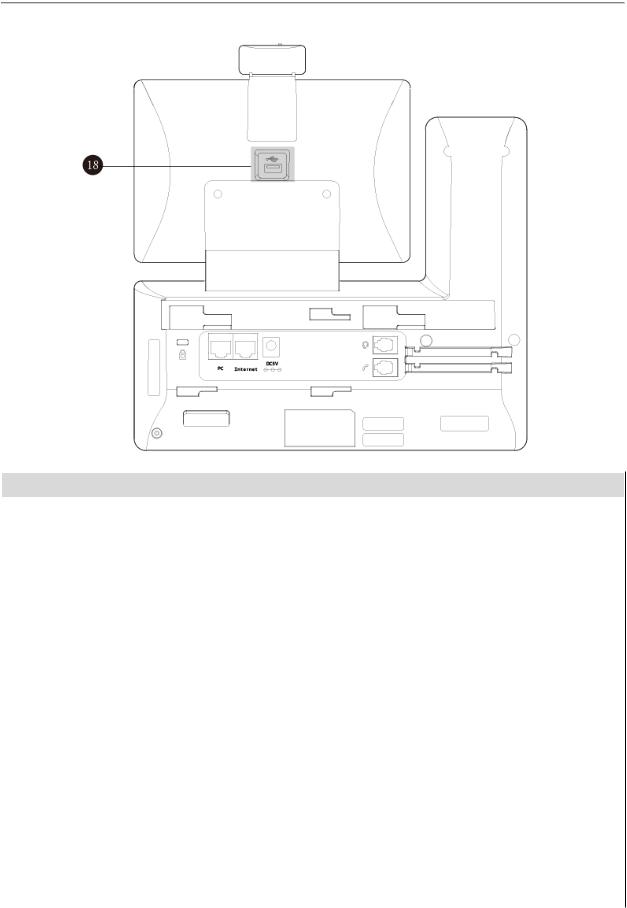
Yealink VP59& SIP-T58A Phones User Guide
No. |
Item |
Description |
|
|
|
|
|
1 |
Power LED |
Indicates call status, message status and phone’s systemstatus. |
|
|
indicator |
|
|
|
|
Allows you to select items and navigate menus on the touch-sensitive screen. Tap to select |
|
2 |
Touch Screen |
and highlight screen items. |
|
|
|
Shows information about calls, messages, time, date and other relevant data. |
|
3 |
HEADSET Key |
Toggles and indicates the headset mode. The key LEDglows green when headset mode is activ- |
|
|
|
ated. |
|
4 |
MUTE Key |
Toggles and indicates mute feature. The key LEDglows red when the call is muted. |
|
|
|
|
|
5 |
REDIAL Key |
Redials a previously dialed number. |
|
|
|
|
|
6 |
Speakerphone |
Toggles and indicates the hands-free (speakerphone) mode. The key LEDglows green when |
|
|
Key |
the hands-free (speakerphone) mode is activated. |
|
7 |
TRANSFER Key |
Transfers a call to another party. |
|
|
|
|
|
8 |
HOLDKey |
Places a call on hold or resumes a held call. |
|
|
|
|
|
9 |
MESSAGE Key |
• Accesses voice mails. |
|
|
|
• Captures screenshots during a video call. |
|
10 |
Volume Key |
Adjusts the volume of the handset, headset and speaker. |
|
|
|
|
|
11 |
Keypad |
Provides the digits and special characters in context-sensitive applications. |
|
|
|
|
|
12 |
Speaker |
Provides hands-free (speakerphone) audio output. |
|
|
|
|
|
13 |
Reversible Tab |
Secures the handset in the handset cradle when the phone is mounted vertically. For more |
|
|
|
|
|
16

Getting Started with Your Phone
No. |
Item |
Description |
|
|
|
|
|
|
|
information on how to adjust the reversible tab, refer to Yealink Wall Mount Quick Installation |
|
|
|
Guide for Yealink IP Phones. |
|
|
|
• Picking up the handset fromthe handset cradle, the hookswitch bounces and the phone con- |
|
14 |
Hookswitch |
nects to the line. |
|
|
|
• Laying the handset down on the handset cradle, the phone disconnects fromthe line. |
|
15 |
Camera Lens |
2Mega-pixel camera. Provides near-site video. The better distance between camera and |
|
|
|
images you want to capture should be in the range of 0.35meters (1foot) to 2meters (6feet). |
|
16 |
Camera LED |
Indicates video call status and camera status. |
|
|
Indicator |
|
|
17 |
Privacy Shutter |
Covers and uncovers the camera. When the camera is switched off, the video image is black. |
|
|
|
|
|
18 |
USB2.0Port |
Allows you to connect an optional USB flash drive/EXP50/USB headset/DD10K to your phone. |
|
|
|
|
|
Power LED Indicator
The power LEDindicator indicates the call and message status.
LED Status |
Description |
|
|
Solid red |
The phone is initializing. |
|
|
Fast-flashing red (0.3s) |
The phone is ringing. |
|
|
Slow-flashing red (1s) |
The phone receives a voice mail. |
Solid red for 0.5s and off for 3s alternately The phone enters the power-saving mode.
Note
The above introduces the default LED status. Your system administrator can configure the status of the power LED indicator.
Camera LED Indicator
The camera LEDindicator indicates the phone and camera status.
LED Status |
Description |
|
|
|
The phone is powered on and the camera is properly connected to the phone. |
Solid green |
The camera is idle. |
|
The phone receives an audio-only call. |
|
|
Flashing green |
The phone receives a video call. |
|
|
|
There is an active video call. |
Solid red |
The video call is muted. |
|
The video call is held. |
|
|
|
The shutter switch is open, but the near-site video is stopped transmitting dur- |
Slow-flashing red |
ing a video call. |
|
The video call is placed on hold. |
|
The phone is powered off. |
Off |
The camera is not properly connected to the phone. |
|
The shutter switch is closed. |
17
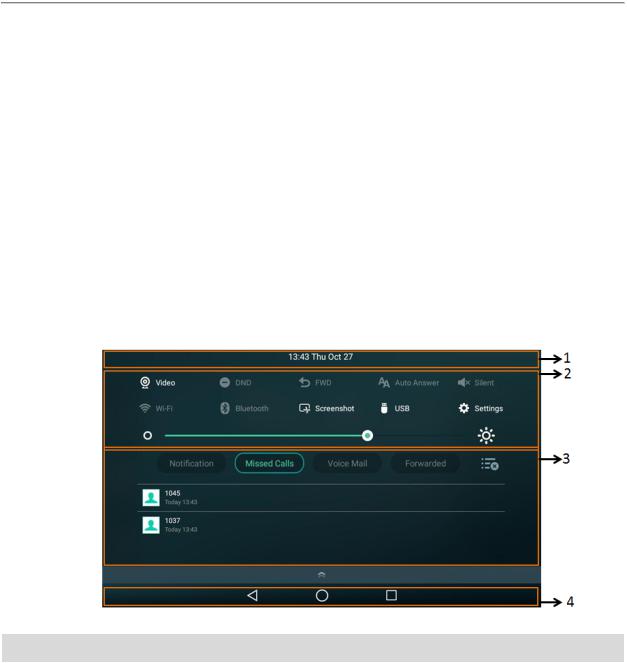
Yealink VP59& SIP-T58A Phones User Guide
Screen and Icons
The user screens and icon indicators can help you navigate and understand the important information of the phone's status.
Topics
Control Center and Notification Center
Idle Screen
Video Call Screen
Icons in the Status Bar
Line Key Icons
Control Center and Notification Center
Control center or notification center allows you to access some features or view important notifications quickly.
Procedure
1. Swipe down fromthe top of the screen.
No. |
Name |
|
Description |
|
|
|
|
|
|
1 |
Time and date |
Display the phone’s time and date. |
||
|
|
|
|
|
|
|
Video |
• Tap to access the Camera when the phone is idle. |
|
|
|
• Tap to stop transmitting video during a video call. |
||
|
|
|
||
|
|
|
|
|
|
|
DND |
Tap to turn on/off DNDquickly. |
|
|
|
|
|
|
|
|
FWD |
Tap to enter Call Forward setting screen. |
|
2 |
Control Center |
|
|
|
Auto Answer |
Tap to enter Auto Answer setting screen. |
|||
|
|
|||
|
|
|
|
|
|
|
Silent |
Tap to turn on/off Silent quickly. |
|
|
|
|
|
|
|
|
Wi-Fi |
• Tap to turn on/off Wi-Fi quickly. |
|
|
|
|
|
|
18

Getting Started with Your Phone
No. |
Name |
Description |
|
|
|
|
|
|
|
|
• Long tap to enter the Wi-Fi setting screen. |
|
|
|
|
|
|
Bluetooth |
• Tap to turn on/off Bluetooth quickly. |
|
|
• Long tap to enter the Bluetooth setting screen. |
|
|
|
|
|
|
|
|
|
|
|
Screenshot |
Tap to capture a screenshot. |
|
|
|
|
|
|
USB |
Tap to access the File Manager to manage the files in the USB |
|
|
flash drive. |
|
|
|
|
|
|
|
|
|
|
|
Settings |
Tap to enter the Settings screen. |
|
|
|
|
|
|
Backlight |
Drag the slider to adjust the screen brightness quickly. |
|
|
|
|
•Tap Notification/Missed Calls/Voice Mail/Forwarded to view the corresponding notification list.
3 Notification Center • Tap the desired notification message to view the details.
•Swipe left or right to delete a specific notification.
•Tap  to delete all notifications.
to delete all notifications.
:tap to go back to the previous screen.
4 Android Keys |
: tap to return to the idle screen. |
|
: tap to view and manage the list of recently used applications. |
|
|
You can swipe up fromthe bottomof the screen to hide this screen. |
|
Idle Screen
The phone has three idle screens by default. You can swipe left or right to switch among different idle screens.
You can add a new idle screen by moving an application or widget to the right side of the third idle screen. This idle screen will be deleted automatically if there is no application or widget on it.
Topics
The Home Screen
The Second Idle Screen
The Third Idle Screen
Related Topic
Managing Applications and Widgets
The Home Screen
On the home screen, you can view the phone's current state, add line keys, and access the dialing, Directory, and History screens.
19
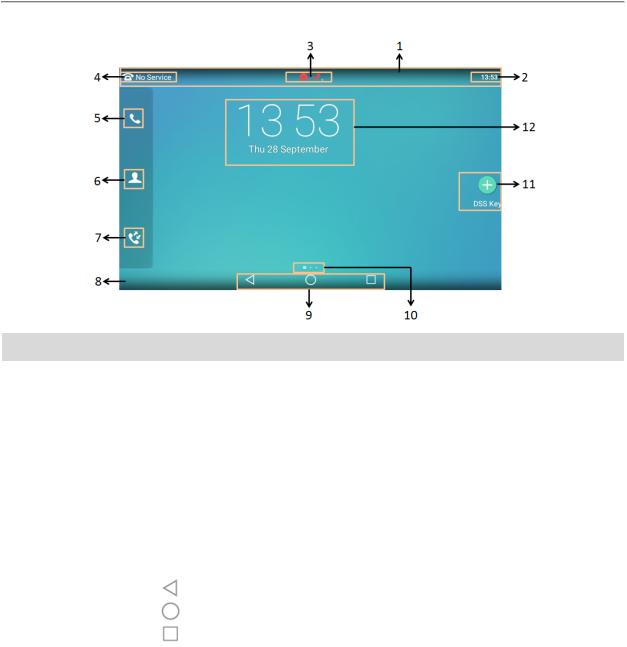
Yealink VP59& SIP-T58A Phones User Guide
No. |
Name |
Description |
|
|
|
|
|
1 |
Status Bar |
Displays the phone’s default account, icons and time. |
|
|
|
|
|
2 |
Time |
The phone’s time is displayed on the right of the status bar. |
|
|
|
|
|
3 |
Icons |
Icons are displayed in the middle of the status bar. |
|
|
|
|
|
4 |
Default account |
The label of the default account is displayed on the left of the status bar. |
|
If there is no account registered on the IP phones, this field will display No Service. |
|||
5 |
Phone Dialer |
Tap to enter the dialing screen. |
|
|
|
|
|
6 |
Directory |
Tap to enter the Directory screen and view contacts. |
|
|
|
|
|
7 |
History |
Tap to enter the History screen and view call history. |
|
|
|
|
|
8 |
Wallpaper |
Shows the specified wallpaper, which can be customized. |
|
|
|
|
|
|
|
: tap to go back to the previous screen. |
|
9 |
Android Keys |
: tap to return to the idle screen. |
|
|
|
: tap to view and manage the list of recently used applications. |
|
|
|
|
|
10 |
Screen Indicator |
Indicates which idle screen is displayed. |
|
|
|
|
|
11 |
DSSKey |
Tap to add a line key, and then the line key list will be displayed on the right of the home |
|
screen. |
|||
|
|
||
|
|
|
|
12 |
Digital Clock Wid- |
Displays the phone’s time and date. |
|
get |
|||
|
|
|
The Second Idle Screen
The second idle screen displays phone’s systemapplications by default.
20
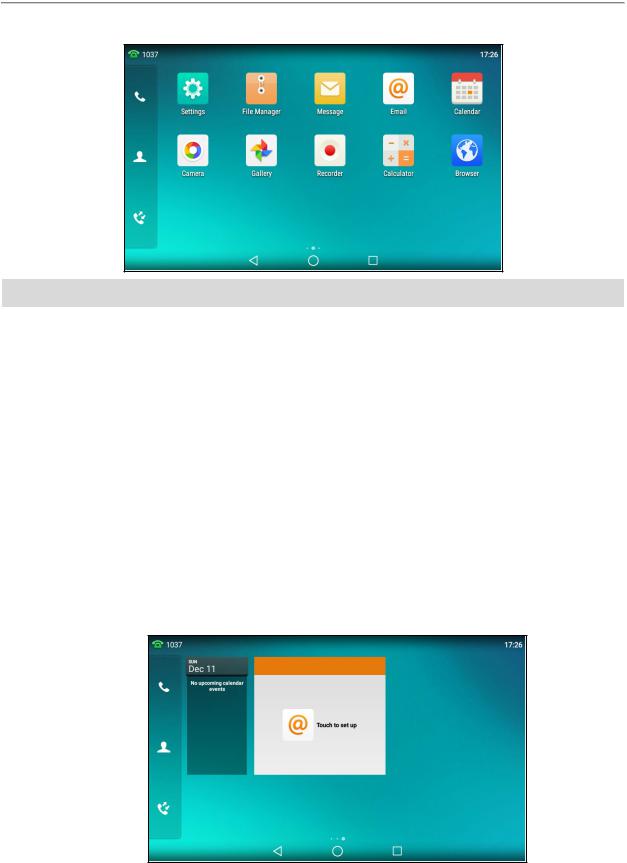
Getting Started with Your Phone
No. |
Application |
Description |
|
|
|
1 |
Settings |
To access phone settings and features. |
|
|
|
2 |
File Manager |
To manage files in the internal SDcard as well as USB flash drive. |
|
|
|
3 |
Message |
To access the video/voice mails or leave video/voice mails for someone. |
|
|
|
4 |
To send and receive emails. |
|
|
|
|
5 |
Calendar |
You can use this application as a reminder or to manage and arrange your events. |
|
|
|
6 |
Camera |
To take pictures or record videos. |
|
|
|
7 |
Gallery |
To view photos and videos. |
|
|
|
8 |
Recorder |
To record audio. |
|
|
|
9 |
Calculator |
To quickly calculate numbers |
|
|
|
10 |
Browser |
To present and explore content on the World Wide Web. |
|
|
|
The Third Idle Screen
The third idle screen displays the calendar and email widgets by default.
21
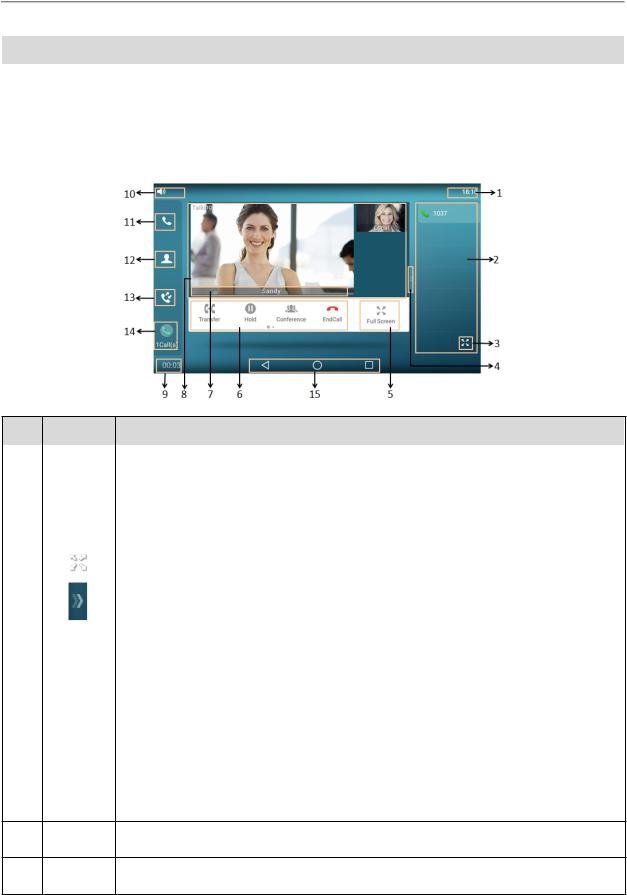
Yealink VP59& SIP-T58A Phones User Guide
No. |
Widget |
Description |
|
|
|
1 |
Calendar |
Displays the data and upcoming events. |
|
|
|
2 |
Displays email list of the specified folder. |
|
|
|
|
Video Call Screen
On the video call screen, you can view the video of far site and near site.
No. |
Name |
Description |
|
|
|
|
|
1 |
Time |
The phone’s time is displayed on the right of the status bar. |
|
|
|
|
|
|
|
The line key list displays 6line keys by default. You can drag up and down to scroll through the |
|
2 |
Line Key List |
line keys. Various features can be assigned to line keys. Each line key can display the label and |
|
indicate the status of the assigned feature. |
|||
|
|
Note: The line key list appears only if you have added at least one line key. |
|
|
|
|
|
3 |
|
Tap to unfold line key list and display all line keys. |
|
|
|
|
|
4 |
|
Tap it or swipe right to hide the line key list. |
|
|
|
|
|
5 |
Full Screen |
Tap to show the near-site (no video if USB camera is not connected) and far-site videos on the |
|
phone in full screen. |
|||
|
|
|
|
6 |
Soft Keys |
• Labelled automatically to identify their context-sensitive features. |
|
• Swipe left to see other soft keys. |
|||
|
|
||
|
|
|
|
7 |
Far-Site |
Shows the information (name or number) of the far site. |
|
Information |
|||
|
|
|
|
|
|
Shows the video of far site and near site. |
|
|
Active Call |
By default, a small window (near site) is located on the top-right of the phone screen, and a lar- |
|
8 |
Window |
ger window (far site) is centered in the middle of the phone screen. |
|
|
|
Note: If you do not connect the USB camera to your phone or turn off the near-site video during |
|
|
|
the call, the phone will stop transmitting the near-site video. |
9Call Duration Shows the duration time of current call. Timer
10 |
Talking |
Shows that you are talking using the handset, speakerphone or headset. You can alternate |
Mode |
among the three modes during calls. |
22
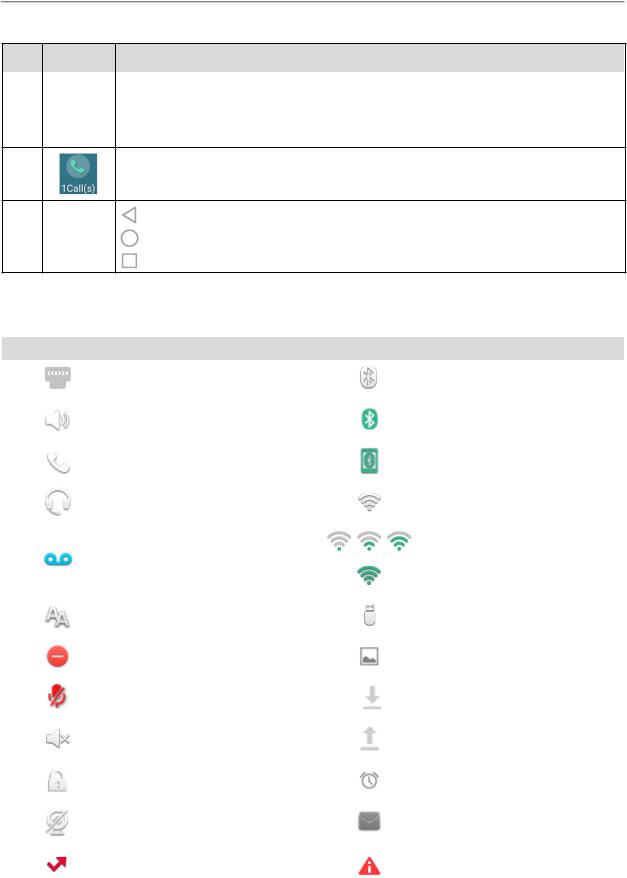
Getting Started with Your Phone
No. |
Name |
Description |
|
|
|
11 |
Phone Dialer |
Tap to enter the dialing screen. |
|
|
|
12 |
Directory |
Tap to enter the Directory screen and view contacts. |
|
|
|
13 |
History |
Tap to enter the History screen and view call history. |
• A number under the icon indicates the number of call(s) on the phone. For example, 1indic-
14ates that there is a call on the phone.
•Tap to exit or return to the talking screen.
:tap to go back to the idle screen.
15 Android Keys |
: tap to return to the idle screen. |
|
: tap to view and manage the list of recently used applications. |
Icons in the Status Bar
The icons in the status bar help you easily get the current phone status, such as call and message status.
Icons |
Description |
Icons |
Description |
|
|
|
|
|
Wired network is unavailable |
|
Bluetooth mode is on |
|
|
|
|
|
Speakerphone (hands-free) mode |
|
Bluetooth headset is both paired and |
|
|
connected |
|
|
|
|
|
|
|
|
|
|
Handset mode |
|
Bluetooth-enabled mobile phone |
|
|
paired and connected |
|
|
|
|
|
|
|
|
|
|
Headset mode |
|
Wi-Fi mode is on |
|
|
|
|
|
Voice Mail |
|
Wi-Fi signal strength fromweak to |
|
|
strong after connecting successfully |
|
|
|
|
|
|
|
|
|
|
Auto Answer |
|
The USB flash drive is detected |
|
|
|
|
|
Do Not Disturb (DND) |
|
Screenshot captured |
|
|
|
|
|
Keep Mute |
|
Downloading file |
|
|
|
|
|
Silent Mode |
|
Uploading file |
|
|
|
|
|
Phone Lock |
|
Upcoming alarm |
|
|
|
|
|
Camera is not detected |
|
Unread email |
|
|
|
|
|
Missed Calls |
|
Phone Warning |
|
|
|
|
23
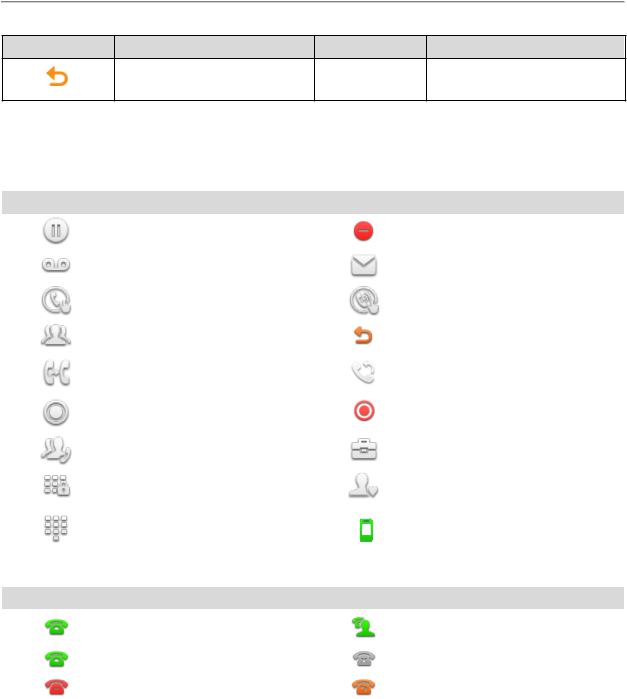
Yealink VP59& SIP-T58A Phones User Guide
Icons |
Description |
Icons |
Description |
Call Forward
Line Key Icons
By viewing the line key icons, you can easily get the function of the line key.
Icon indicators (associated with line key features)
Icons |
Description |
Icons |
Description |
|
|
|
|
|
Hold |
|
DND |
|
|
|
|
|
Voice Mail |
|
SMS |
|
|
|
|
|
Direct Pickup |
|
Group Pickup |
|
|
|
|
|
Conference |
|
Forward |
|
|
|
|
|
Transfer |
|
Recall |
|
|
|
|
|
Record |
|
Recording in process |
|
|
|
|
|
Multicast Paging |
|
Hot Desking |
|
Paging List |
|
|
|
|
|
|
|
|
|
|
|
Phone Lock |
|
Directory |
|
|
|
|
|
Speed Dial |
|
DECT Intercom |
|
|
|
|
Icon indicators (associated with line)
Icons |
Description |
Icons |
Description |
|
|
|
|
|
The private line registers suc- |
|
The shared/bridged line registers suc- |
|
cessfully. |
|
cessfully. |
|
|
|
|
|
Registering. |
|
Register failed. |
|
|
|
|
|
DNDis enabled on this line. |
|
Call forward is enabled on this line. |
|
|
|
|
Navigating Menus and Fields
You can use different gestures on the touch screen to performvarious operations.
Procedure
1. To operate your phone using gestures, follow these tips:
24

|
|
Getting Started with Your Phone |
|
|
|
Gesture |
Action |
|
|
|
|
Tap |
|
Touch an itemon the screen with your finger, and then lift your finger. |
|
|
|
Long Tap |
|
Touch an itemfor about 2seconds without lifting your finger fromthe screen till an action |
|
occurs. |
|
|
|
|
|
|
|
Swipe |
|
Touch and move. When you want to scroll quickly, swipe your finger across the screen, either |
|
up, down, left or right. |
|
|
|
|
|
|
|
Drag |
|
Touch and hold, then move. To stop scrolling, stop the dragging motion. |
|
|
|
Pinch |
|
Touch the screen with two or more fingers, and then move the fingers away fromeach other |
Open |
|
(stretch). |
|
|
|
Pinch |
|
Touch the screen with two or more fingers, and then move the fingers towards each other |
Close |
|
(pinch). |
|
|
|
Entering Information
The phone provides onscreen keyboard, phone keypad and dial pad to enter data. Phone keypad and dial pad provide a standard key layout, which enables you to use existing or familiar key positions.
Topics
Using the Onscreen Keyboard
Using the Phone Keypad and Dial Pad
Using the Onscreen Keyboard
The phone supports two kinds of input methods: English (UK) and Google Pinyin for the onscreen keyboard. You can enter information into text fields using the touch screen.
When you use the onscreen keyboard, the following things you need to know:
If you want to |
Action |
Position the cursor. |
Tap to the position. |
1.Long tap the entered character(s).
2.Do one of the following:
Select all characters.
•Tap SELECT ALL on the top of the phone screen.
•Drag  /
/  to select all characters.
to select all characters.
Cut/Copy characters. |
1. Long tap the entered character(s). |
25
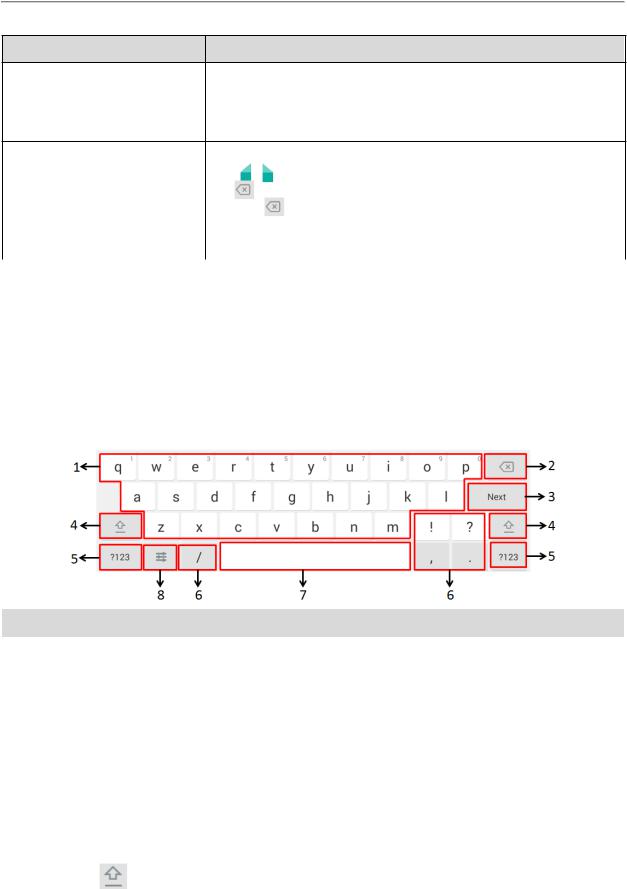
Yealink VP59& SIP-T58A Phones User Guide
If you want to |
Action |
2.Drag  /
/  to select the characters you want to cut/copy.
to select the characters you want to cut/copy.
3.Tap CUT/COPY on the top of the phone screen.
4.Long tap the desired field.
5.Tap PASTE.
• Long tap the entered character(s). |
||
Drag |
/ |
to select the characters you want to delete. |
Delete more characters at a time. |
. |
|
Tap |
|
|
• Long tap |
. |
|
|
||
1. Drag your finger to highlight the characters you want to replace. |
||
Replace characters. |
|
|
2. Tap the desired character. |
||
Related Topic |
|
|
Changing the Input Method |
|
|
Topics |
|
|
English (UK) Input Method |
|
|
Google Pinyin Input Method |
|
|
English (UK) Input Method
You can use the English (UK) input method to enter information.
No. |
Item |
|
Description |
|
|
|
|
|
|
|
|
|
• Tap to enter letters. |
|
1 |
26English Letters |
|
• Long tap a key then slide to choose one of the options to enter an alternate char- |
|
|
|
|
acter. |
|
2 |
Delete Key |
|
• Tap to delete the entered characters one by one. |
|
|
• Long tap to delete two or more characters. |
|||
|
|
|
||
|
|
Next |
Tap to go to the next field. |
|
|
|
Key |
|
|
|
Label automatically |
Done |
Tap to confirmthe settings. |
|
3 |
to identify the con- |
Key |
||
|
||||
text-sensitive fea- |
Send |
Tap to dial out the number. |
||
|
tures. |
Key |
||
|
|
|
||
|
|
Go Key |
Tap to browse the web page. |
|
|
|
|
|
|
4 |
|
|
Tap to switch to the uppercase input mode. |
|
|
|
|
|
26
